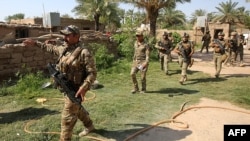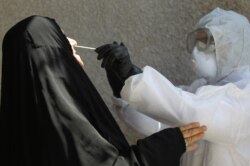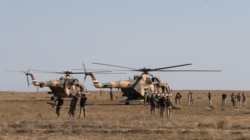With the spread of the novel coronavirus in Iraq and a recent spike in the number of registered cases, Iraqis have wondered how to compare the deadly new threat with a more familiar foe: Islamic State.
Many Iraqis have in recent weeks found the jihadists to be more lethal than COVID-19, particularly in northern provinces disputed between the central government in Baghdad and the Kurdistan Regional Government (KRG) in Irbil, according to local government officials.
Iraq announced its first coronavirus case in late February. The country’s health ministry has since reported 13 deaths from the virus in the disputed provinces of Kirkuk, Diyala, Saladin and Nineveh.
The reported killing of civilians and security forces by IS in those provinces, however, has reached at least 50 people.
“Certainty, Daesh is stronger here” said Husham Alhashimi, a Baghdad-based terrorism expert with the Center for Global Policy, using an Arabic acronym for IS.
“In some of these areas, there are no security forces, whether from the federal government or the peshmerga,” he told VOA by phone from Iraq.
The peshmerga is the military force of the Kurdistan Regional Government.
Strict limits
To prevent the further spread of the coronavirus, Iraqi authorities have imposed a strict lockdown, banning all “nonessential” traffic, public gatherings and businesses nationwide.
The restrictions at first appeared to yield results. That changed in May when the country saw a major spike in the days following the Ramadan Eid festival, when the government relaxed its curfew.
As of Friday, the Iraqi health ministry has confirmed 9,846 cases, with 4,573 recovered and 258 dead. The capital, Baghdad, remains the epicenter of the pandemic with more than half of the country’s cases.
While the rest of the country struggles to contain the new wave of the contagious virus, the disputed territories seem to be least prone to it. That is, according to some experts, mainly due to a stiffer lockdown and increased IS activity, limiting population movement in the area.
“Sometimes at around 2 pm, [security forces] facilitate some movement here and there for people to go to the bazaar and return home, but after that they will impose a complete curfew, especially at night,” said Azad Shukr, a journalist based in Kirkuk.
No man’s land
The disputed territories cover a large swath of ethnically and religiously diverse territory in the four provinces and have long been considered a hotbed for extremism. They are oil-rich areas claimed by both Baghdad and the KRG.
In 2014, when IS took control of Mosul in a major assault, the peshmerga seized the region after Iraqi army units abandoned their positions.
The Kurdish military was forced out in October 2017, when the Iraqi army and Iran-backed Shiite militia stormed in following the Kurdish independence referendum. The Iraqi army and the Shiite Popular Mobilization Forces (PMF) are now in control of urban areas, but much of the rural terrain along the Hamrin mountain ridge remains a no man’s land.
Local intelligence sources report as many as 3,000 IS fighters could be using the area as a stronghold where they hide, train and plan attacks.
With Iraq’s attention largely switched to COVID-19, experts warn that IS faces less pressure in the disputed lands and is ready to reorganize its sleeper cells.
“The key reason for the group’s ability to operate in the disputed areas is simply the existence of gaps,” said Hassan Hassan, an expert on the group.
IS, he maintained, “thrives in places where it doesn’t have one enemy or a set of enemies that coordinate well with each other.”
Coalition role
The U.S.-led coalition announced in March that it had halted its training of Iraqi security forces because of the spread of the coronavirus. The coalition at the same time handed over the K-1 Airbase in Kirkuk to Iraqi forces.
Despite reduced activities in Iraq, the global coalition is continuing to provide Iraqi Security Forces (ISF) with air support against IS sleeper cells, Colonel Myles B. Caggins, the coalition’s spokesman, told VOA.
“Daesh is unable to hold physical territory,” said Caggins, adding that the ISF in the second half of May alone conducted 35 operations that killed or captured dozens of IS fighters and removed hundreds of weapons and explosives.
Kurdish officials charge that the reduced activity of the coalition has allowed IS to breathe again. The region in recent weeks has faced a string of assassinations, kidnappings, suicide bombings and use of improvised explosive devices, as well as arson attacks on hundreds of acres of Kurdish farmers’ ripe wheat fields. Local officials blame IS for the violence.
While IS has not claimed responsibility for every incident in the region, it has owned the major attacks, including a series of coordinated assaults in May that killed nearly a dozen PMF members.
In an audio recording released in late May, IS spokesperson Abu Hamza al-Quraishi encouraged IS insurgents and sympathizers to increase their activities against the Iraqi government targets. Al-Quraishi, in the message, described COVID-19 as a punishment for “the crusaders,” promising that “great opportunities” were ahead for the diminished group.
“Over the past two months, IS activities have occurred almost daily,” Mohsin Dosky, a ruling-party member on the Security Committee of the Kurdistan parliament, told VOA.
“There is no ruler in that area,” said Dosky, claiming that the return of the peshmerga to the region was required to bring back stability and ensure a lasting defeat of IS.
“Iraq can neither control it nor allow the peshmerga to return to it,” he added.
The Iraqi government, however, says security of the urban areas in the provinces remains largely under control, with some skirmishes reported outside cities. Last month, the government under new Prime Minister Mustafa al-Kadhimi sent reinforcements from ISF to Kirkuk to confront IS remnants.
Some Iraq observers say the rise in jihadist attacks on the disputed territories does not mean IS’s physical caliphate is about to be restored. They nevertheless warn IS could further stir ethnic and sectarian tensions.
“I don’t think Daesh is ever going to succeed in reestablishing territorial control.” David Mack, a former U.S. ambassador and Iraq expert at the Atlantic Council, told VOA.
According to David Pollock, a Kurdish affairs expert with the Washington Institute for Near East Policy, a more durable strategy to defeat IS in the region requires Baghdad and Irbil to reach a compromise on the region and join forces against the Islamist group.
The presence of U.S. troops, he said, provides an opportunity for both sides to reach a resolution.
“Sooner or later, the outside powers are going to gradually start pulling away from this, reducing their presence and their support, so you’ve got to really take advantage of it while it’s there,” he said.









